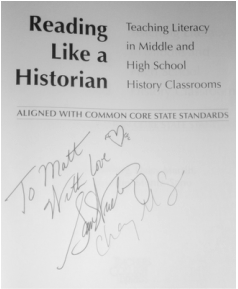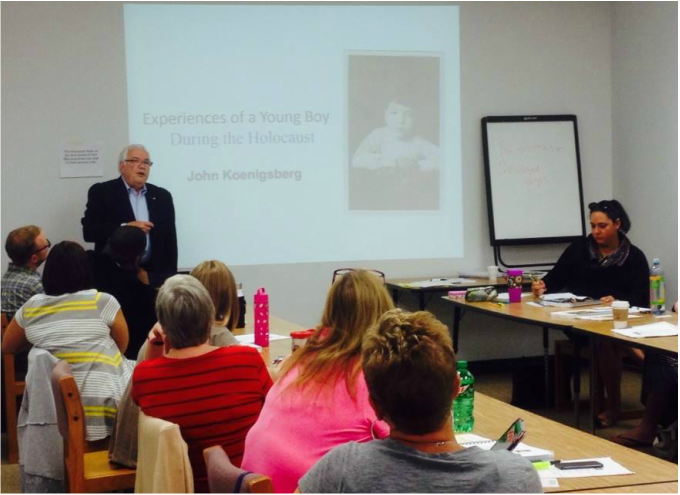Reflections and Collections for the 21st Century Social Studies Classroom
 Rather than recommending a specific bibliography of works worth reading, I find it easier to recommend historians and social studies educators whose works I have found useful. This is especially true in recent years, as "works" are often in the form of websites, lesson plans, MOOCs, blogs, and tweets, not just traditional books and articles. I have been compiling names over the last three years, and I am now finally getting around to sharing it publicly, in no particular order. While the majority teach social studies education at the university level, others are university history professors, high school teachers, or education consultants. I should also add a disclaimer that the inclusion of a particular individual in this list does not mean I agree with or endorse every opinion they express. My list is by no means exhaustive or conclusive, and I am always open to suggestions. Who do you follow? Click on the names below for academic homepages or personal websites or follow the Twitter handles indicated.
6/13/2015 Are PowerPoint Presentations the New Film Strips? Creating Interactive PowerPoint PresentationsBy Matt Doran  I recently came across my old filmstrip collection, which I believe has now officially passed from audio-visual aid to historic artifact. Most of the filmstrips are accompanied by a cassette tape that beeps as a signal to move to the next slide. Others require human narration. For the record, I am not old enough to have actually taught using filmstrips. I am, however, old enough to have watched them as a student. As I looked through my collection, a question came to mind: has pedagogy changed in thirty years, or are PowerPoint presentations just the new filmstrips? While filmstrips could provide a helpful visual supplement to a lecture, they were largely a passive experience for students. Students might be required to take notes or answer some questions, but the content was largely pre-determined unless the teacher ad-libbed. By the turn of the 21st century, filmstrips, slide projectors, and overhead transparencies were being replaced by PowerPoint presentations. Today, PowerPoint is often viewed a symbol of stand-and-deliver direction instruction (lecturing), which has fallen out of favor for more constructivist pedagogy. As the Grant Wiggins recently noted, history teachers appear to be the most likely to spend a large percentage of time lecturing, at the expense of other student-centered approaches. It is important to remember that PowerPoint is only software with a blank canvas (and some fancy themes). It is neither inherently good nor bad--it all depends on how it is used. A PowerPoint presentation need not be a canned lecture or scripted narration. When used effectively with interactive features, PowerPoint has far greater potential than a prefab film strip. Here are four suggestions for creating interactive PowerPoint presentations. Vocabulary Games Vocabulary instruction is a critical component of students' academic success, and 55 percent of students' academic vocabulary comes from social studies disciplines. In Robert Marzano's Six-Step Process for Building Academic Vocabulary, step 6 requires involving students in games that enable them to play with terms. Games for vocabulary development should include student-to-student interaction. Tech savvy educators have created PowerPoint game templates that can be customized to meet specific course vocabulary. These include games like Password, Pyramid, and Taboo. For more PowerPoint game templates, see the links from FMI Teaching Resources and UNCW EdGames. Teachers can also create their own templates, using hyperlinks within the presentation. (See the directions in the Contingency and Decision-Making section below.) Visual Discovery and Spiral Questions Teachers' Curriculum Institute, publisher of the popular History Alive! materials, uses visual discovery to increase engagement. Students view and interpret a few powerful images on a historical topic. As slides are presented, teachers pose a series of spiral questions on three levels. Students can assume the role of detective as they answer the questions and record notes in a graphic organizer. In Level 1 questions, student detectives gather evidence by identifying the people, places and things. (What do you see in the image?) In Level 2, student detectives begin to interpret the evidence and make inferences about time period, place, or people in the scene. Students should begin to defend their answers with “because” statements. Questions focus on what, when, where, and who. In Level 3, student detectives must use the evidence and their own critical thinking skills to make hypotheses about what is happening and why. Questions at this level emphasize why and how questions and require justifying, synthesizing, predicting, and evaluating. Checking for Understanding - Clickers and Poll Everywhere Student response systems (clickers) provide an easy and quick way for teachers to check for understanding. TurningPoint is an add-in to PowerPoint. Teachers can create new presentations in TurningPoint or use existing PowerPoint presentations and add in new slides. These new slides include multiple choice items in which students can respond to questions with remote response cards. Results are tallied and displayed in a chart in real-time within the PowerPoint presentation. Teachers can save the session to track individual and group progress over time. (Note: Plickers is a free alternative that allows teachers to collect real-time data through a web browser and teacher smart phone or tablet, without the need for student devices.) Poll Everywhere is an app that allows teachers to ask multiple choice or open-ended questions. Teachers create questions using the online app. Once the poll is activated, it can be downloaded as a PowerPoint slide and inserted to another presentation. Students can respond to questions via the web, text message or Twitter. As the students respond, results appear instantly on the slide. Graphs change and move and open ended answers roll in for everyone to see. Poll Everywhere now includes a PollEv Presenter Add-in option for PowerPoint. Teachers can download the add-in to create new polls directly in PowerPoint, and navigate between poll slides. In addition to checking for understanding, Poll Everywhere questions work well as brainstorming warm-up questions, such as a K-W-L activity. Choose Your Own Adventure - Contingency and Decision-Making PowerPoint presentations, like textbooks, often present history as a linear narrative of what happened in the past, without much consideration to contingency and decision-making. In their article, What Does it Mean to Think Historically?, Thomas Andrews and Flannery Burke write, "To argue that history is contingent is to claim that every historical outcome depends upon a number of prior conditions; that each of these prior conditions depends, in turn, upon still other conditions; and so on. . . Contingency demands that students think deeply about past, present, and future. It offers a powerful corrective to teleology, the fallacy that events pursue a straight-arrow course to a pre-determined outcome, since people in the past had no way of anticipating our present world. Contingency also reminds us that individuals shape the course of human events. . ." PowerPoint presentations do not have to flow in sequential order. Instead, slides can be hyperlinked in a such a way that students choose from a set of decision-points and view possible consequences of their choices, allowing students to better understand the underlying and immediate causes of historical events. The Smart Art graphics in PowerPoint provide a variety of options to generate list, process, hierarchy, or relationship graphic organizers. To hyperlink an element of the organizer, click on the element and select Hyperlink from the Insert tab. Next, click on Place in This Document and link to another slide. Above all, simply avoid death by PowerPoint by using the tool to promote interactive and engaging strategies, instead of rote lectures. Echoes and Reflections, a leader in Holocaust education, provided a free, full-day workshop for teachers (English and Social Studies) in our district this week. Our presenter was Alexis Storch, Director of Education at the Center for Holocaust and Humanity Education in Cincinnati, Ohio. She was joined by powerful testimony from John Koenigsberg, a Holocaust survivor. Here are some of the key takeaways for me.
The Humanity of All
Agency and Choice
Propaganda and Prejudice
Telling the Stories
|
Blog Categories
All
Blog Archives
August 2020
|

 RSS Feed
RSS Feed

6/17/2015
5 Comments